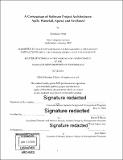A comparison of software project architectures : agile, waterfall, spiral, and set-based
Author(s)
West, Christian J. (Christian Joseph)
DownloadFull printable version (22.29Mb)
Other Contributors
Massachusetts Institute of Technology. Integrated Design and Management Program.
Advisor
Bryan R Moser.
Terms of use
Metadata
Show full item recordAbstract
Engineers and managers of software projects have the daunting task of successfully delivering the right product at the right time for the right price. The path to achieving these lofty goals is commonly not a straightforward endeavor. Due to the dynamic nature of software development, varying organizational circumstances, and situational idiosyncrasies of each project this can be a very difficult and sensitive process. Ideally, software development methodologies bring order to the chaos of software development. An ill-fitting development strategy, however, can create unnecessary friction and further complicate the prospect of a successful product delivery. Researchers and private organizations alike spend substantial resources to understand the strengths and weaknesses of commonly used development practices - the validation of which is highly problematic due to conflicting variables. This research ventures to bring clarity to the question: "Which development methodology is right for a particular situation?" Treating the software development project life-cycle as a socio-technical system, it can be decomposed to the most fundamental elements. Using these elements as the architectural building blocks of a project, Agile, Waterfall, Set-Based, and Spiral are each compared at the molecular level. This thesis evaluates these comparisons and how subsequent research applies to today's software projects.
Description
Thesis: S.M. in Engineering and Management, Massachusetts Institute of Technology, System Design and Management Program, 2018. Cataloged from PDF version of thesis. Includes bibliographical references (pages 99-101).
Date issued
2018Department
Massachusetts Institute of Technology. Engineering and Management Program; Massachusetts Institute of Technology. Integrated Design and Management Program.Publisher
Massachusetts Institute of Technology
Keywords
Engineering and Management Program., Integrated Design and Management Program.